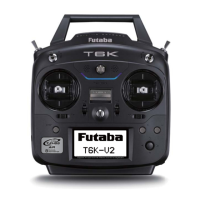Introduction
10
Neverflyonarainyday,whenthewindis
strong,andatnight.
■Watercouldleadtofailureorimproperfunctionality
andpoorcontroloftheaircraftwhichcouldleadtoa
crash.
Neverturnthepowerswitchonandoffduring
flightorwhiletheengineormotorisrunning.
■Operationwillbecomeimpossibleandtheaircraftwill
crash.Evenifthepowerswitchisturnedon,operation
willnotbeginuntiltransmitterandreceiverinternal
processingiscomplete.
Donotstarttheengineormotorwhilewearing
theneckstrap.
■Theneckstrapmaybecomeentangledwiththe
rotatingpropeller,rotor,etc.andcauseaseriousinjury.
Donotflywhenyouarephysicallyimpairedas
itcouldposeasafetyhazardtoyourselforothers.
Donotflyatthefollowingplaces:
■ Nearanotherradiocontrolflyingfield.
■ Nearorabovepeople.
■ Nearhomes,schools,hospitalsorotherplaceswhere
peoplecongregate.
■ Nearhighvoltagelines,highstructures,or
communicationfacilities.
Whensettingthetransmitterontheground
duringflightpreparations,donotstanditup-
right.
■Thetransmittermaytipover,thesticksmay
moveandthepropellerorrotormayrotateunexpectedly
andcauseinjury.
Donottouchtheengine,motor,orFETamp
duringandimmediatelyafteruse.
■Theseitemsmaybecomehotduringuse.
Forsafety,flysothattheaircraftisvisibleatall
times.
■Flyingbehindbuildingsorotherlargestructures
willnotonlycauseyoutolosesightoftheaircraft,but
alsodegradetheRFlinkperformanceandcauselossof
control.
Fromthestandpointofsafety,alwayssetthe
failsafefunction.
■Inparticular,normallysetthethrottlechanneltoidle.
Forahelicopter,setthethrottlechanneltomaintaina
hover.
Whenflying,alwaysreturnthetransmitterset-
upscreentotheHomescreen.
■Erroneousinputduringflightisextremelydangerous.
Alwayschecktheremainingcapacityofthe
transmitterandreceiverbatteriesbeforeeachfly-
ingsessionpriortoflight.
■Lowbatterycapacitywillcauselossofcontrolanda
crash.
Alwayscheckoperationofeachcontrolsurface
andperformarangetestbeforeeachflyingses-
sion.Also,whenusingthetrainerfunction,check
theoperationofboththeteacherandstudent
transmitter.
■ Evenonetransmittersettingoraircraftabnormality
causeacrash.
Beforeturningonthetransmitter:
1.Alwaysmovethetransmitterthrottlestickpositionto
theminimum(idle)position.
2.Turnonthetransmitterfirstandthenthereceiver.
Whenturningoffthetransmitter'spower
switch.Aftertheengineormotorhasstopped
(stateinwhichitwillnotrotateagain):
1.Turnoffthereceiverpowerswitch.
2.Thenturnoffthetransmitterpowerswitch.
■Ifthepowerswitchisturnedon/offintheopposite
order,thepropellermayrotateunexpectedlyandcausea
seriousinjury.
■Alsoalwaysobservetheaboveorderwhensettingthe
failsafefunction.
■Maximumlow throttle:Directioninwhichthe engine
ormotorrunsattheslowestspeedorstops.
Whenadjustingthetransmitter,stoptheen-
gineexceptwhennecessary.Inthecaseofamo-
tor,disconnectthewiringandtoallowittocon-
tinueoperation.Whendoingso,pleaseexer-
ciseextremecaution.Ensurethattheaircraftis
securedandthatitwillnotcomeintocontact
withanythingoranyone.Ensurethatthemotor
willnotrotatepriortomakinganyadjustments.
■Unexpectedhighspeedrotationoftheenginemay
causeaseriousinjury.

